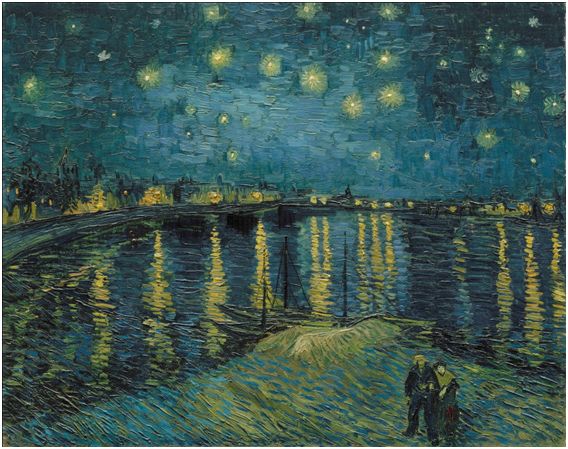"...Natural आणि supernatural यांतील सीमारेषा अस्पष्ट आहे, अंधूक आहे, असे जी. ए. कुलकर्णी यांना वाटत असे आणि या शोधात असताना त्यांनी अनेक अज्ञात लेखकांची पुस्तके केवळ कुतूहलाने नव्हे तर जबरदस्त ओढ वाटल्यामुळे वाचली होती..."
(पृष्ठ : सव्वीस, 'जी.एं.ची निवडक पत्रे: खंड १', १९९५)
(प्रा म. द. हातकणंगकलेकरांनी जी.ए.न वरती एक लेख लिहला होता, त्याचे शीर्षक : धारवाडचे धुके)
एप्रिल २०१९च्या दि न्यू यॉर्क रिव्ह्यू ऑफ बुक्स मधला Boyd
Tonkin यांचा "
From Writer to Painter: Van Gogh’s London Pilgrimage" लेख वाचायला सुरुवात केली आणि खालील चित्र समोर आले:
Vincent van Gogh, Starry Night,
१८८८
... आणि हे चित्र पाहताच व्हिस्टलर आणि गोडसे आठवले... एकही शब्द वाचायच्या आधी... आणि मग हे वाचायला मिळाले आणि ते वाचून खूप आनंद झाला:
".... Van Gogh loved the mysterious cityscapes and
moody weather of London, finding a “peculiar beauty” in its suburbs. The
visionary qualities of the writers, painters, and engravers he discovered in
the city helped to guide his eye and brush until his death, in 1890. They aided
his pursuit of “a reality more real than reality,” as he’d put it to Theo, that
he mastered in the sensual starbursts of his later paintings, such as Starry
Night from 1888, with its firework-like explosions of light reflected
as golden pillars in the dark waters of the Rhône at Arles. In the show, it
sits alongside a Whistler Nocturne of the shadowy Thames. Van Gogh
knew and admired Whistler’s Thames-side scenes. In the clear-skied Midi,
clarity and outline would replace the swirling murk of polluted London. But
even as Van Gogh’s latitudes changed, his attitudes persisted. In turn,
successive generations of Van Gogh emulators and acolytes in Britain drew on
his breakthroughs in color and form..."
त्या पोस्ट मधील Nocturne च्या संबंधातील माहिती पुन्हा लिहतो :
कै द ग गोडसेंनी व्हिस्टलर (James Abbott McNeill Whistler) १८३४-१९०३ वरती दोन अप्रतिम लेख लिहले आहेत. ते त्यांच्या 'नांगी असलेले फुलपाखरू', १९८९ पुस्तकाच्या सुरवातीलाच छापले आहेत.
गोडसे व्हिस्टलरांच्या व्यक्तिमत्वावर व कलेवर फार खुष होते, हे आपल्याला
पदोपदी जाणवते....
एका ठिकाणी (पृष्ठ ४०) गोडसे व्हिस्टलर लेखात लिहतात :
वरील वर्णन बऱ्याच प्रमाणात खालील चित्राला लागू आहे.
Nocturne in Blue and Gold: Old Battersea Bridge, १८७२- ७५
सौजन्य : विकिमीडिया कॉमनस
Nocturne- Blue and Silver - Chelsea, १८७१
सौजन्य : विकिपीडिया



